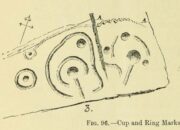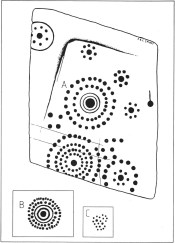Cup-and-Ring Stone: OS Grid Reference – NX 68649 44700
Also Known as:
- Balmae House
- Balmae 5 (Coles)
Archaeology & History

Amongst a good cluster of petroglyphs, this ornate little fella may have been one visited by George Hamilton (1886) when he visited Balmae and outlying districts, seeking out petroglyphs! We don’t know for certain though, as his descriptions are somewhat vague. However, a few years later the great Fred Coles (1895) came a-wandering in search of the same carvings and, as happens in this line of business, uncovered a few new ones during his rummaging. This was one of them, which he described, very simply, as hiding
“but a few yards from Ross View Cottage, on its N.W. … (with) eight cups being associated with four rings and several grooves, both straight and curved.”
It was only a few years later when the Royal Commission lads (1911) came in search of it and they told how,
“the main design is a central ringed cup with a connected groove, and two outer cups which an outer circle curves eccentrically to enclose.”
But when Ron Morris (1979) explored the area in the 1970s, he was unable to locate this and a number of other carvings that had been reported by Coles. Since then, the carving has been relocated at the grid reference cited above. Also since then, a great deal many more carvings have been found in this locale by the experienced petroglyphic fingers of Maarten van Hoek. (1993)
References:
- Coles, Fred, “A Record of the Cup-and-Ring Markings in the Stewartry of Kirkcudbright,” in Proceedings Society Antiquaries, Scotland, volume 29, 1895.
- Hamilton, George, “Notices of Rock Sculpturings of Cups and Circles in Kirkcudbrightshire,” in Proceedings Society Antiquaries, Scotland, volume 21, 1886.
- Morris, Ronald W.B., The Prehistoric Rock Art of Galloway and the Isle of Man, Blandford: Poole 1979.
- Royal Commission Ancient & Historical Monuments, Scotland, Inventory of Monuments and Constructions in Galloway – volume 2: County of the Stewartry of Kirkcudbright, HMSO: Edinburgh 1914.
- van Hoek, M., “Balmae”, in Discovery & Excavation Scotland, 1993.
Links:
© Paul Bennett, The Northern Antiquarian

